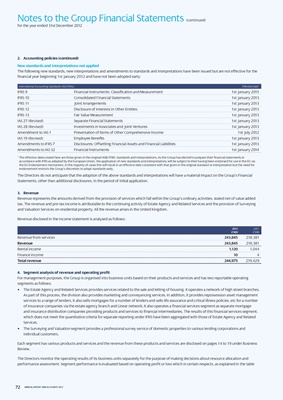
Notes to the Group Financial Statements (continued)
for the year ended 31st December 2012
2. Accounting policies (continued)
new standards and interpretations not applied
The following new standards, new interpretations and amendments to standards and interpretations have been issued but are not effective for the
financial year beginning 1st January 2012 and have not been adopted early:
International Accounting Standards (IAS/IFRSs) Effective date1
IFRS 9 Financial Instruments: Classification and Measurement 1st January 2015
IFRS 10 Consolidated Financial Statements 1st January 2013
IFRS 11 Joint Arrangements 1st January 2013
IFRS 12 Disclosure of Interests in Other Entities 1st January 2013
IFRS 13 Fair Value Measurement 1st January 2013
IAS 27 (Revised) Separate Financial Statements 1st January 2013
IAS 28 (Revised) Investments in Associates and Joint Ventures 1st January 2013
Amendment to IAS 1 Presentation of Items of Other Comprehensive Income 1st July 2012
IAS 19 (Revised) Employee Benefits 1st January 2013
Amendments to IFRS 7 Disclosures: Offsetting Financial Assets and Financial Liabilities 1st January 2013
Amendments to IAS 32 Financial Instruments 1st January 2014
1
The effective dates stated here are those given in the original IASB/IFRIC standards and interpretations. As the Group has elected to prepare their financial statements in
accordance with IFRS as adopted by the European Union, the application of new standards and interpretations will be subject to their having been endorsed for use in the EU via
the EU Endorsement mechanism. In the majority of cases this will result in an effective date consistent with that given in the original standard or interpretation but the need for
endorsement restricts the Group’s discretion to adopt standards early.
The Directors do not anticipate that the adoption of the above standards and interpretations will have a material impact on the Group’s Financial
Statements, other than additional disclosures, in the period of initial application.
3. Revenue
Revenue represents the amounts derived from the provision of services which fall within the Group’s ordinary activities, stated net of value added
tax. The revenue and pre-tax income is attributable to the continuing activity of Estate Agency and Related Services and the provision of Surveying
and Valuation Services on residential property. All the revenue arises in the United Kingdom.
Revenue disclosed in the income statement is analysed as follows:
2012 2011
£’000 £’000
Revenue from services 243,845 218,381
Revenue 243,845 218,381
Rental income 1,120 1,044
Finance income 10 4
total revenue 244,975 219,429
4. Segment analysis of revenue and operating profit
For management purposes, the Group is organised into business units based on their products and services and has two reportable operating
segments as follows:
• The Estate Agency and Related Services provides services related to the sale and letting of housing. It operates a network of high street branches.
As part of this process, the division also provides marketing and conveyancing services. In addition, it provides repossession asset management
services to a range of lenders. It also sells mortgages for a number of lenders and sells life assurance and critical illness policies, etc for a number
of insurance companies via the estate agency branch and Linear network. It also operates a financial services segment as separate mortgage
and insurance distribution companies providing products and services to financial intermediaries. The results of this financial services segment,
which does not meet the quantitative criteria for separate reporting under IFRS have been aggregated with those of Estate Agency and Related
Services.
• The Surveying and Valuation segment provides a professional survey service of domestic properties to various lending corporations and
individual customers.
Each segment has various products and services and the revenue from these products and services are disclosed on pages 14 to 19 under Business
Review.
The Directors monitor the operating results of its business units separately for the purpose of making decisions about resource allocation and
performance assessment. Segment performance is evaluated based on operating profit or loss which in certain respects, as explained in the table
72 ANNUAL REPORT AND ACCOUNTS 2012